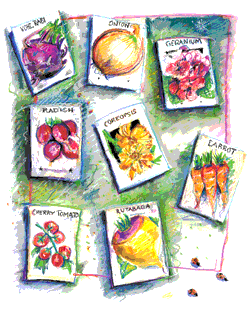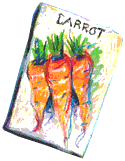Seed diversity, food security
by Trudy Bialic and Colleen Foye Bollen
This article was originally published in May 2002

Variety is the basis of good nutrition, so seed diversity is essential to our health.
Historically, about 10,000 plant species have been used for human food. Today, only about 150 plant species make up the diets of most of the world’s people. Of these, only 12 species provide more than 70 percent of our food. Nearly 75 percent of the genetic diversity of agricultural crops has been lost since the early 1900’s. Our nutrition and food security are vulnerable.
The role of hybrids is one factor, but there’s more going on. Vandana Shiva, author of “Stolen Harvest” and Director of the Research Foundation for Science, Technology and Natural Resource Policy, says we’re witnessing “the emergence of food totalitarianism, in which a handful of corporations control the entire food chain and destroy alternatives” through genetic engineering, patents on seeds, and mergers.
A disastrous outcome is not inevitable. Consumers and home gardeners can shape the future. PCC’s farmers lead the way.
Who controls the food supply?
The free exchange of seeds among farmers has been the basis of biodiversity and food security for millennia. It gave us the diversity of plants that provide us nutrition.
But by 1990, biotechnology became more profitable than chemical weapons and the giant chemical companies, says Shiva, clearly began “repositioning themselves as ‘life science’ companies, whose goal was to control agriculture.”

“In 1997,” writes Shiva, “Monsanto spun off its chemical division and spent $6 billion acquiring seed companies like Cargill International Seed and DeKalb Genetics. DuPont spun off its petroleum division, Conoco, and formed a $1.7 billion ‘research alliance’ with Pioneer Hi-Bred International, the world’s largest seed company. The world’s largest agrochemical company, Aventis, bought Plant Genetic Systems, which already had patents on strains of corn and wheat.”¹
Corporations like RiceTec in Texas are claiming patents on Basmati rice (“Texmati”), which farmers in India bred out long ago. “The soybean, which evolved in East Asia, has been patented by Calgene, which is now owned by Monsanto. Calgene also owns patents on mustard, a crop of Indian origin.
“Today,” according to Shiva, “10 corporations control 32 percent of the commercial seed market. They also control the global agrochemical and pesticide market. Just five corporations control global trade in grain.”²
These major seed companies are offering fewer and fewer varieties of seeds, and most sell only hybrids which require human intervention. Many seed corporations market the same variety of crops worldwide, creating a monoculture that replaces hundreds of local crop varieties.
Diversity is security
Industrial farmers in the United States failed to learn the importance of plant diversity from the infamous Irish potato famine in the 1840s. Blight destroyed the staple food of subsistence-level Irish under British rule. More than a million people died and another two million fled starvation and disease.
In 1970, corn blight devastated more than 14 percent of the total U.S. corn crop. The corn was susceptible because more than 70 percent of it came from the same parent lines.
Bringing old seed strains back into production is essential for increasing the declining genetic diversity of flowers, fruits and vegetables. That means growing heirloom plants, the ancestors of the plant world.
Heirloom varieties are time-tested varieties that have been saved for generations because of treasured traits such as flavor, vigor, and hardiness. They’re repositories of characteristics important to biodiversity; the best are survivors of stressful times.

Seed savers
In direct response to the destructive corn blight, concerned farmers and gardeners started grassroots seed preservation groups. Realizing increased diversity meant greater resilience within the ecosystem, their focus was to save seeds from extinction.
Nash Huber of Dungeness Organic Produce was one of them. The spinach he grows for PCC comes from seed stock he started saving 15 years ago. He saves seeds from his crops every year and is working on breeding out a Baby Bok Choy hybrid back to the original parental traits. “You can go backwards, genetically,” says Huber.
“Different varieties of plants hold different resistance for pests and disease,” says Ned Hubert, Farm Manager for Abundant Life Seeds, a mail order seed company promoting the conservation and use of heirloom, native, and rare seeds.” Any natural system’s main strength is the genetic diversity within that system.” That’s why orchardists like Mark LaPierre, who provides cherries, nectarines, and apples to PCC, says he has planted a much higher level of diversity on his land than customary.
The lessons apply to backyard gardens, too. “One of the best things home gardeners can do for the environment and themselves is to grow a variety of heirloom seeds,” says Hubert. Diversity helps home gardeners maintain a healthy insect and arthropod population, necessary for carrying pollen from one plant to another. On a grand scale, a larger demand for these seeds means more small-scale farmers can make a living growing these seeds.

Heirlooms vs. hybrids
Even farmers and gardeners not interested in heirlooms or in saving seeds need to know that plants grown from hybrid seeds may fail to benefit ecosystems. Gardeners might like larger, double flowers and fruits with longer blooming seasons that come in a wider variety of colors, but these hybrid flowers may not produce nectar for hummingbirds. They may bloom too late for bees, or not attract bees because the flower is yellow instead of blue.
On the other hand, hybrids such as carrots have strong tops, uniform size and color, and the entire crop ripens at the same time. Uniformity in appearance and harvest time are key reasons farmers embraced hybrid seeds in the 1940s.
While hybrids have some outstanding qualities, the ability to reproduce is not one of them. Breeding hybrids requires human intervention. The plants produce seeds that don’t grow out “true to type.” A hybrid plant’s seed won’t have many characteristics that made its parent noteworthy. In fact, the seed may not grow at all. Farmers must buy hybrid seed year after year.
Heirloom plants are from “open-pollinated” seeds and depend on natural pollination by insects, water and the wind. They require no human manipulation and grow out true to their ancestors. The seed of open pollinated plants may be saved by farmers year after year. Home gardeners appreciate the staggered ripening process that gives them ripe produce on an ongoing basis.
Heirlooms have another advantage. “Each year your plants get acclimated to your specific soil and climate,” says Steve Peters, Developer and Procurement Manager for Seeds of Change, a company that sells only certified organic and open-pollinated varieties. “Gardeners who save open-pollination seeds and replant them will see improved crops within two to three years.”
Nash Huber of Dungeness Organic Produce says that’s true; his own strains from saved seed get better and better. The natural changes also increase the genetic diversity within each crop.
The opportunity
Shrinking plant diversity is one world challenge that individuals can help reverse. Start by refusing to accept life’s diversity as corporate property. Purchase heirloom fruits, vegetables, and flowers. At home, add a few heirloom plants to your gardens and yards. People with no garden space can help by growing heirloom tomatoes or flowers in patio containers.
“The individual and collective action of millions of gardeners can transform backyards, neighborhoods, ecosystems, regions and nations.”³ By planting and buying heirlooms, we can honor the past and help protect the future of plant diversity and food security.
| Heirloom/open pollinated produce at PCC From these local farms: Dungeness Organic Farms, Full Circle Farm, and Rent’s Due Ranch. |
||
|---|---|---|
|
Arugula Beets (Cylinder, “Candy Stripe,” Chiogga) Cabbage (Red) Cauliflower Swiss Chard (all varieties) Cranberry Beans (fresh and dry) Dill (fresh) Endive Fava beans Garlic Lettuce (Green Leaf “Black seeded Simpson”) Lettuce (Red Romaine) Jerusalem artichokes Kale (Red Russian, Green, Lacinato) |
Mixed salad greens (Speckled Lettuce, Red Mustard) Mizuna mustard greens Pumpkins (New England Pie) Ornamental corn Parsnip Potatoes (Yellow Finn, Fingerling, Blue) Radish (White Icicle, French Breakfast, Purple) Spinach Squash (Hubbard, Delicata) Tomatoes (Brandywine, Stupice, Red Pear, Yellow Pear, Purple, and Striped German) |
Plant starts from Rent’s Due Ranch Gourmet Salad Mix Spicy Salad Mix Braising Mix Garlic Gypsy Bell Pepper Tomatoes (Brandywine, Yellow Brandywine, Black Plum, Green Grape, Green Zebra, Persimmon, Prudence Purple) |
Related links:
- Shiva,Yes! a journal of positive futures, summer 2000
- Ibid.
- www.seedsofchange.com
